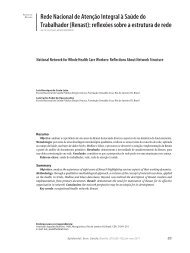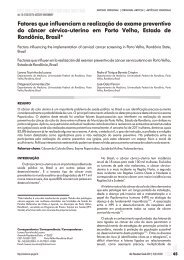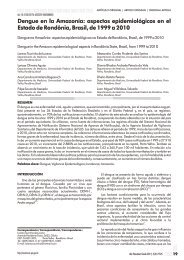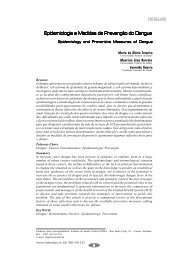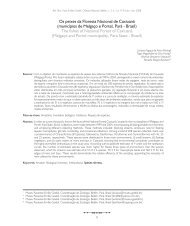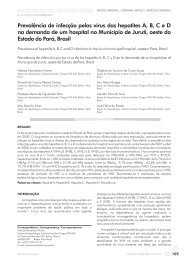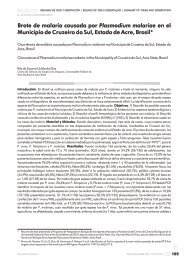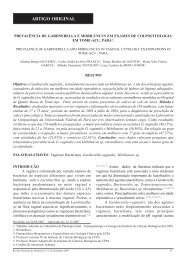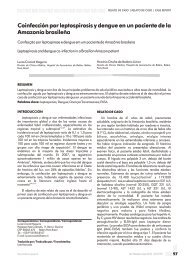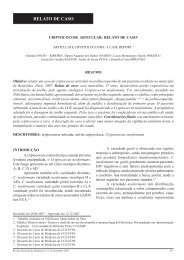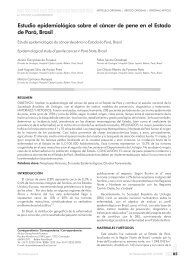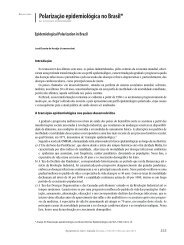The Cholini (Curculionidae: Coleoptera) in the Museu Goeldi ...
The Cholini (Curculionidae: Coleoptera) in the Museu Goeldi ...
The Cholini (Curculionidae: Coleoptera) in the Museu Goeldi ...
You also want an ePaper? Increase the reach of your titles
YUMPU automatically turns print PDFs into web optimized ePapers that Google loves.
Bol. Mus. Para. Emílio <strong>Goeldi</strong>, sér. Ciências Naturais, Belém, v. 1, n. 1, p. 237-241, jan-abr. 2005<br />
<strong>The</strong> <strong>Chol<strong>in</strong>i</strong> (<strong>Curculionidae</strong>: <strong>Coleoptera</strong>) <strong>in</strong> <strong>the</strong> <strong>Museu</strong> <strong>Goeldi</strong> Collection<br />
<strong>Chol<strong>in</strong>i</strong> (<strong>Curculionidae</strong>: <strong>Coleoptera</strong>) na Coleção do <strong>Museu</strong> <strong>Goeldi</strong><br />
Roberta de Melo Valente 1<br />
Fabio Kleverson de Lima Diamant<strong>in</strong>o 2<br />
Crist<strong>in</strong>a de Barros Nunes 2<br />
Resumo: Este trabalho avalia o número de espécies de gorgulhos da tribo <strong>Chol<strong>in</strong>i</strong> depositados na Coleção Entomológica do<br />
<strong>Museu</strong> Paraense Emílio <strong>Goeldi</strong> (MPEG). Na Amazônia Brasileira são registradas 53 espécies de <strong>Chol<strong>in</strong>i</strong>, das quais 51<br />
pertencem à subtribo Chol<strong>in</strong>a e duas à Subtribo Rh<strong>in</strong>ast<strong>in</strong>a (Wibmer; O’Brien, 1986). Na coleção do MPEG foram<br />
identificadas 23 espécies distribuídas em quatro gêneros (Cholus Germar, 1824; Homal<strong>in</strong>otus Sahlberg, 1823;<br />
Odontoderes Sahlberg, 1823 e Ozopherus Pascoe, 1872), todos da subtribo Chol<strong>in</strong>a. Associações de Homal<strong>in</strong>otus<br />
validus (Olivier, 1790) com Attalea maripa (Aubl.) Mart. (<strong>in</strong>ajá) e de Homal<strong>in</strong>otus depressus (L<strong>in</strong>naeus, 1758) com<br />
babaçu (Attalea sp.) foram registradas pela primeira vez na biologia desses besouros. Somente 43% das espécies de<br />
<strong>Chol<strong>in</strong>i</strong> da Amazônia brasileira estão representadas na coleção do MPEG, <strong>in</strong>dicando que o material foi coletado,<br />
casualmente. Novos esforços de coleta, focalizando a relação dos besouros com as plantas hospedeiras, poderiam<br />
aumentar, significativamente, a representação de <strong>Chol<strong>in</strong>i</strong> e de <strong>Curculionidae</strong> na coleção do MPEG.<br />
Palavrasalavras-Chave<br />
Chave: <strong>Chol<strong>in</strong>i</strong>; Coleção; Diversidade; Biologia; Distribuição geográfica; <strong>Museu</strong> Paraense Emílio <strong>Goeldi</strong>-Coleção<br />
Entomológica; Coleóptera; <strong>Curculionidae</strong>.<br />
Abstract: This paper evaluates <strong>the</strong> number of species of weevils of <strong>the</strong> tribe <strong>Chol<strong>in</strong>i</strong> <strong>in</strong> <strong>the</strong> Entomological Collection of <strong>the</strong><br />
<strong>Museu</strong> Paraense Emílio <strong>Goeldi</strong> (MPEG). Fifty-three species of <strong>Chol<strong>in</strong>i</strong> are recorded for Brazilian Amazonia, of which<br />
51 belong to <strong>the</strong> subtribe Chol<strong>in</strong>a and two <strong>the</strong> subtribe Rh<strong>in</strong>ast<strong>in</strong>a (Wibmer; O’Brien, 1986). Twenty-three species<br />
were identified <strong>in</strong> <strong>the</strong> MPEG collection, distributed <strong>in</strong> four genera (Cholus Germar, 1824; Homal<strong>in</strong>otus Sahlberg,<br />
1823; Odontoderes Sahlberg, 1823 e Ozopherus Pascoe, 1872), all <strong>in</strong> <strong>the</strong> subtribe Chol<strong>in</strong>a. Association of Homal<strong>in</strong>otus<br />
validus (Olivier, 1790) with Attalea maripa (Aubl.) Mart. (<strong>in</strong>ajá or maripa palm) and of Homal<strong>in</strong>otus depressus<br />
(L<strong>in</strong>naeus, 1758) with babassu (Attalea sp.) were recorded for <strong>the</strong> first time <strong>in</strong> <strong>the</strong> biology of <strong>the</strong>se beetles. Only 43%<br />
of <strong>the</strong> <strong>Chol<strong>in</strong>i</strong> species <strong>in</strong> <strong>the</strong> Brazilian Amazon are present <strong>in</strong> <strong>the</strong> MPEG hold<strong>in</strong>gs, <strong>in</strong>dicat<strong>in</strong>g <strong>the</strong> material was casually<br />
collected. A new collect<strong>in</strong>g effort focus<strong>in</strong>g on <strong>the</strong>ir relationship with host plants would significantly <strong>in</strong>crease <strong>the</strong><br />
representation of <strong>Chol<strong>in</strong>i</strong> and <strong>Curculionidae</strong> <strong>in</strong> <strong>the</strong> MPEG collection.<br />
Key Words<br />
ords: <strong>Chol<strong>in</strong>i</strong>; Collection; Diversity; Biology; Geographic distribution; <strong>Museu</strong> Paraense Emílio <strong>Goeldi</strong>-Entomological<br />
Collection; <strong>Coleoptera</strong>; <strong>Curculionidae</strong>.<br />
1<br />
UFPA-Universidade Federal do Pará. Departamento de Biologia, Zoologia. Av. Perimetral, s/n. CEP 66.075-110, Belém-PA,<br />
Brasil. (rvalent@nautilus.com.br); <strong>Museu</strong> Paraense Emílio <strong>Goeldi</strong>. Coordenação de Zoologia. Cx. Postal, 399. CEP 66.040-170,<br />
Belém-PA, Brasil. (roberta@museu-goeldi.br)<br />
2<br />
UFPA-Universidade Federal do Pará. Av. Perimetral, s/n. CEP 66.075-110, Belém-PA, Brasil.<br />
237
<strong>The</strong> chol<strong>in</strong>i (currulionidae: coleoptera) <strong>in</strong> <strong>the</strong> <strong>Museu</strong> <strong>Goeldi</strong> collection<br />
INTRODUCTION<br />
This paper evaluates <strong>the</strong> number of species of<br />
weevils <strong>in</strong> species of <strong>the</strong> tribe <strong>Chol<strong>in</strong>i</strong> (<strong>Coleoptera</strong>,<br />
<strong>Curculionidae</strong>) deposited <strong>in</strong> <strong>the</strong> Entomological<br />
Collection of <strong>the</strong> <strong>Museu</strong> Paraense Emílio <strong>Goeldi</strong><br />
(MPEG), <strong>in</strong> Belém, Pará State, nor<strong>the</strong>rn Brazil.<br />
<strong>The</strong> MPEG collection holds 10,418 specimens of<br />
<strong>Curculionidae</strong>, of which only 6,725, or 55% have<br />
been identified to genus or species level (215 genera<br />
and 131 species) Costa et al., 2000. This centenary<br />
collection is vital to studies <strong>in</strong> biodiversity, systematics<br />
and evolution of Amazonian <strong>in</strong>sects, and <strong>in</strong>cludes<br />
material from regions already affected by human<br />
<strong>in</strong>tervention such as Carajás and Tucuruí, Pará State.<br />
However, many <strong>in</strong>sect orders, <strong>in</strong>clud<strong>in</strong>g <strong>Coleoptera</strong>,<br />
have not been properly studied due to <strong>the</strong> lack of<br />
specialists <strong>in</strong> <strong>the</strong> region.<br />
<strong>The</strong> <strong>Curculionidae</strong> (weevils) are <strong>the</strong> most diverse<br />
family <strong>in</strong> <strong>the</strong> entire animal k<strong>in</strong>gdom. No less than<br />
thirty-one subfamilies are recorded <strong>in</strong> Brazil, <strong>in</strong> a<br />
total of 4,934 species grouped <strong>in</strong>to 648 genera<br />
(Van<strong>in</strong>, 1999). <strong>The</strong> tribe <strong>Chol<strong>in</strong>i</strong> itself <strong>in</strong>cludes 53<br />
species <strong>in</strong> <strong>the</strong> Amazonian region, 51 of <strong>the</strong> subtribe<br />
Chol<strong>in</strong>a and two of Rh<strong>in</strong>ast<strong>in</strong>a (Wibmer; O’Brien,<br />
1986). A third subtribe, Cholom<strong>in</strong>a, has not been<br />
recorded <strong>in</strong> <strong>the</strong> area.<br />
METHODS<br />
Adult specimens of <strong>Chol<strong>in</strong>i</strong> deposited <strong>in</strong> <strong>the</strong><br />
Entomological Collection of <strong>the</strong> MPEG were<br />
exam<strong>in</strong>ed. Identification relied on published genusand<br />
species-level keys (Vaurie, 1973 a, b, 1974 a,<br />
b, 1975, 1976 a, b, 1977, 1978), orig<strong>in</strong>al<br />
descriptions and comparison with previously<br />
identified material from <strong>the</strong> entomological<br />
collections of <strong>the</strong> <strong>Museu</strong> Paraense Emílio <strong>Goeldi</strong><br />
and <strong>Museu</strong> de Zoologia da Universidade de São<br />
Paulo (MZUSP). Classification followed Wibmer;<br />
O’Brien, 1986.<br />
<strong>The</strong> species distribution map was based on<br />
<strong>in</strong>formation from <strong>the</strong> labels of <strong>the</strong> exam<strong>in</strong>ed material.<br />
Description on labels (Table 1) <strong>in</strong>cluded <strong>the</strong> follow<strong>in</strong>g<br />
items: total number of specimens, country, state,<br />
city, locality, number of specimens by sex and<br />
biological <strong>in</strong>formation (Papavero, 1994). Specimens<br />
with locality <strong>in</strong>formation limited to <strong>the</strong> name of <strong>the</strong><br />
country or state were not recorded on <strong>the</strong> map.<br />
Specimens presumed from localities <strong>in</strong> Brazilian<br />
Amazonia are listed <strong>in</strong> Table 2 under <strong>the</strong> category<br />
Amazonian species; all o<strong>the</strong>rs were placed under<br />
non-Amazonian species.<br />
RESULTS AND DISCUSSION<br />
A total of 254 specimens were exam<strong>in</strong>ed and<br />
identified as belong<strong>in</strong>g to 23 species of <strong>the</strong> subtribe<br />
Chol<strong>in</strong>a (Table 1). As a registry of <strong>the</strong> entomological<br />
fauna of Brazilian Amazonia, <strong>the</strong> <strong>Museu</strong> Paraense<br />
Emílio <strong>Goeldi</strong> collection <strong>in</strong>cludes, respectively, 43%<br />
and 45% of <strong>the</strong> diversity of <strong>Chol<strong>in</strong>i</strong> and Chol<strong>in</strong>a for<br />
this region.<br />
<strong>The</strong> material exam<strong>in</strong>ed were collected almost<br />
exclusively <strong>in</strong> Brazilian Amazonia, along <strong>the</strong> Amazon<br />
river and <strong>in</strong> <strong>the</strong> vic<strong>in</strong>ities of <strong>the</strong> city of Belém. Only<br />
two specimens were not collected <strong>in</strong> Brazil, one of<br />
Cholus calamita (Pascoe, 1872) from Colombia and<br />
one of Cholus rana (Fabricius, 1801) from Peru<br />
(Table 1, Figure 1).<br />
Among <strong>the</strong> genera of Chol<strong>in</strong>a recorded for Brazilian<br />
Amazonia, only <strong>the</strong> monotypic Ozopherus Pascoe,<br />
1872 is fully represented <strong>in</strong> <strong>the</strong> <strong>Museu</strong> Paraense<br />
Emílio <strong>Goeldi</strong> collection. <strong>The</strong> genera Cholus<br />
Germar, 1824, Homal<strong>in</strong>otus Sahlberg, 1823 and<br />
Odontoderes Sahlberg, 1823 respectively <strong>in</strong>clude<br />
64%, 42% and 10% of <strong>the</strong> diversity of species<br />
recorded for this region. <strong>The</strong> genera, Ameris<br />
Dejean, 1821 and Lobaspis Chevrolat, 1881 are<br />
absent from <strong>the</strong> collection (Table 2).<br />
Biological <strong>in</strong>formation on <strong>the</strong> material exam<strong>in</strong>ed<br />
referred to Homal<strong>in</strong>otus depressus (L<strong>in</strong>naeus, 1758)<br />
and Homal<strong>in</strong>otus validus (Olivier, 1790), be<strong>in</strong>g both<br />
associated with babassu palm (Attalea sp.) and Attalea<br />
maripa (Aubl.) Mart. (<strong>in</strong>ajá or maripa palm) trees.<br />
238
Bol. Mus. Para. Emílio <strong>Goeldi</strong>, sér. Ciências Naturais, Belém, v. 1, n. 1, p. 237-241, jan-abr. 2005<br />
Table 1. Specimens of <strong>the</strong> tribe <strong>Chol<strong>in</strong>i</strong> <strong>in</strong> <strong>the</strong> MPEG Entomological Collection.<br />
Cholus annulatus (L<strong>in</strong>naeus) 1758. 1 specimen. BRASIL. Goiás: São Sebastião, Dianópolis (1 ).<br />
Cholus boisduvali Boheman, 1836. 1 specimen. BRAZIL. Pará: Rio Paru de Oeste, Maloca Tiryó (1 ).<br />
Cholus calamita Pascoe, 1872. 2 specimens. BRAZIL. Pará: Serra Norte, Caldeirão (1 ). COLOMBIA (no locality) (1 ).<br />
Cholus coloreus Vaurie, 1976. 1 specimen. BRAZIL. Amapá: Calçoene (1 ).<br />
Cholus conspicillatus Chevrolat, 1881. 3 specimens. BRAZIL. Amazonas: Maraã, Ilha Jaragui (1 ); Itaquatiara, Rio Urubu (1 ).<br />
Rondônia: Ouro Preto do Oeste, Rio Santa Helena road (1 ).<br />
Cholus jekelii (Kirsch) 1875. 7 specimens. BRAZIL. Acre: Rio Branco (2 ; 5 ).<br />
Cholus laticollis (Olivier) 1807. 26 specimens. BRAZIL. Pará: Belém, Mocambo (5 , 1 ), Ut<strong>in</strong>ga (4 , 3 ); Benevides (7 , 4 ); Santo<br />
Antônio do Tauá (1 ); (no locality) (1 ).<br />
Cholus notabilis Pascoe, 1872. 2 specimens. BRAZIL. Pará: Tucuruí, Igarapé Maguari (1 ); Ilha das Onças (1 ).<br />
Cholus nyblaei Boheman, 1836. 2 specimens. BRAZIL. Amapá: Porto de Santana (2 ).<br />
Cholus patruelis Chevrolat, 1882. 7 specimens. BRAZIL. Acre: Rio Branco, Armadilha Malayse, Terra firme (1 ). Amazonas: Tefé<br />
(1 ). Pará: Barcarena (1 ); Belém (2 ); Cassiporé (2 ).<br />
Cholus rana (Fabricius) 1801. 5 specimens. BRAZIL. Pará: Belém (1 ); Bujaru (1 ); Mocambo (1 ; 1 ). PERU: Iquitos, (no locality)<br />
(1 ).<br />
Cholus repetitus Chevrolat, 1882. 1 specimen BRAZIL. Pará: Monte Dourado (1 ).<br />
Cholus sagittarius Vaurie, 1976. 5 specimens. BRAZIL. Mato Grosso: Fazenda Buruti (1 ; 3 ); Chapada dos Guimarães (1 ).<br />
Cholus sparsus (Gyllenhal) 1836. 6 specimens. BRAZIL. Amapá: Rio Calçoene, Igarapé Tigre (1 ); Serra Lombardi, Limão (2 , 1 ).<br />
Pará: Cassiporé (1 ); Monte Dourado (1 ).<br />
Cholus tril<strong>in</strong>eolatus Klima, 1936. 2 specimens. BRAZIL. Pará: Serra Norte, Pojuca acampamento (1 ); Rio Gelado (1 ).<br />
Cholus trizonatus Guen<strong>the</strong>r, 1943. 2 specimens. BRAZIL. Acre: Rio Branco (1 , 1 ).<br />
Homal<strong>in</strong>otus depressus (L<strong>in</strong>naeus) 1758. 64 specimens. BRASIL. Amapá: Rio Matapi (1 ). Maranhão: Lago Verde (3 , 3 ); Peritoró<br />
(1 ). Pará: Acará (2 , 1 ); Belém (1 , 2 ); Muaná (1 ); São João de Pirabas (1 ); Serra Norte (1 , 2 ); Soure (1 ); Tucuruí (1 , 1 ),<br />
Tucuruí, on <strong>in</strong>aja palm (6 , 2 ), Tucuruí, on babassu palm (1 ), Bagagem (2 , 1 ), Chiqueirão (2 ), Chiqueir<strong>in</strong>ho (1 ), Cocal (1 ,<br />
2 ), Ilha (5 ), Jacundá (11 , 5 ), Saúde (1 ). Tocant<strong>in</strong>s: Itaguat<strong>in</strong>s (2 ).<br />
Homal<strong>in</strong>otus humeralis (Gyllenhal) 1836. 3 specimens. BRAZIL. Pará: Breves (1 ); Tucuruí, Ilha (1 ), Saúde (1 ).<br />
Homal<strong>in</strong>otus nodipennis (Chevrolat) 1878. 1 specimen. BRAZIL. Pará: Óbidos (1 ).<br />
Homal<strong>in</strong>otus praelongus Vaurie, 1973. 1 specimen. BRAZIL. Pará: Acará, Ilha do Combu (1 ).<br />
Homal<strong>in</strong>otus validus (Olivier) 1790. 107 specimens. BRAZIL. Maranhão: Lago Verde (9 , 13 ), Lago Verde, on babassu palm (1 ).<br />
Pará: Acará, Ilha de Combu (3 , 1 ); Belém (1 ); São Miguel do Guamá (1 ); Tucuruí (2 ), Tucuruí, on <strong>in</strong>aja palm (6 , 5 ), Bagagem<br />
(6 , 4 ), Cocal (3 , 2 ), Canoal (1 , 4 ), Chiqueirão (1 ), Chiqueir<strong>in</strong>ho (1 , 3 ), Ilha II (2 , 1 ), Jacundá (15 ,10 ). Tocant<strong>in</strong>s:<br />
Itaguat<strong>in</strong>s (8 , 4 )<br />
Odontoderes morbillosus (Drury) 1782. 1 specimen. BRAZIL. Pará: Serra Norte (1 ).<br />
Ozopherus muricatus Pascoe, 1872. 4 specimens. BRAZIL. Amazonas: Manaus (1 ). Pará: Belém (2 ); (no locality) (1 ).<br />
Table 2. Number of species of Chol<strong>in</strong>a known for <strong>the</strong> Amazonian Region and number of species represented <strong>in</strong> <strong>the</strong> MPEG collection.<br />
Genus<br />
Amazonian species<br />
Species <strong>in</strong> MPEG collection<br />
Ameris 1 0<br />
Cholus 25 16<br />
Homal<strong>in</strong>otus 12 5<br />
Lobaspis 2 0<br />
Odontoderes 10 1<br />
Ozopherus 1 1<br />
239
<strong>The</strong> chol<strong>in</strong>i (currulionidae: coleoptera) <strong>in</strong> <strong>the</strong> <strong>Museu</strong> <strong>Goeldi</strong> collection<br />
Figure 1. Localities recorded for species of <strong>Chol<strong>in</strong>i</strong> <strong>in</strong> <strong>the</strong> MPEG collection: 1. Cholus annulatus; 2. C. boisduvali; 3. C. calamita; 4. C.<br />
coloreus; 5. C. conspicillatus; 6. C. jekelii; 7. C. laticollis; 8. C. notabilis; 9. C. nyblaei; 10. C. patruelis; 11. C. rana; 12. C. repetitus;<br />
13. C. sagittarius; 14. C. sparsus; 15. C. tril<strong>in</strong>eolatus; 16. C. trizonatus; 17; Homal<strong>in</strong>otus depressus. 18. H. humeralis; 19. H.<br />
nodipennis; 20. H. praelongus; 21. H. validus; 22. Odontoderes morbillosus; 23. Ozopherus muricatus.<br />
However, <strong>the</strong> collection labels did not <strong>in</strong>clude details<br />
on which part of <strong>the</strong> tree anatomy (flower, fruit, stipe<br />
or leave) <strong>the</strong> weevils were collected (Table 1). <strong>The</strong><br />
association of Homal<strong>in</strong>otus depressus with babassu<br />
and Homal<strong>in</strong>otus validus with <strong>in</strong>ajá represent new<br />
records of host plants for <strong>the</strong>se species.<br />
CONCLUSIONS<br />
In <strong>the</strong> Entomological Collection at <strong>Museu</strong> Paraense<br />
Emílio <strong>Goeldi</strong> are represented 43% of <strong>the</strong> species of<br />
<strong>the</strong> <strong>Chol<strong>in</strong>i</strong> tribe known for <strong>the</strong> Brazilian Amazonia.<br />
<strong>The</strong> association of Homal<strong>in</strong>otus depressus with<br />
babassu and Homal<strong>in</strong>otus validus with <strong>in</strong>aja palm<br />
tree are new records of host plants for <strong>the</strong>se weevils.<br />
<strong>The</strong> specimens of <strong>Chol<strong>in</strong>i</strong> <strong>in</strong> <strong>the</strong> <strong>Museu</strong> Paraense<br />
Emílio <strong>Goeldi</strong> collection were casually collected and<br />
little biological or ecological <strong>in</strong>formation has been<br />
recorded on <strong>the</strong>m. Specific collect<strong>in</strong>g of weevils,<br />
especially directed toward host plants, and an<br />
exchange of material with o<strong>the</strong>r <strong>in</strong>stitutions would<br />
greatly <strong>in</strong>crease <strong>the</strong> representation of <strong>Chol<strong>in</strong>i</strong> and<br />
<strong>Curculionidae</strong> <strong>in</strong> <strong>the</strong> collection.<br />
240
Bol. Mus. Para. Emílio <strong>Goeldi</strong>, sér. Ciências Naturais, Belém, v. 1, n. 1, p. 237-241, jan-abr. 2005<br />
ACKNOWLEDGMENTS<br />
We are grateful to Drs. Ana Harada, Curator of <strong>the</strong><br />
<strong>Museu</strong> Paraense Emílio <strong>Goeldi</strong> Entomological<br />
Collection, for <strong>the</strong> loan of specimens for study; Sergio<br />
Antonio Van<strong>in</strong> (Universidade de São Paulo) for help <strong>in</strong><br />
<strong>the</strong> identification and for access to <strong>the</strong> MZUSP<br />
collection of <strong>Curculionidae</strong>; Luís Cláudio Barbosa<br />
(MPEG) for produc<strong>in</strong>g <strong>the</strong> map; Inocêncio Gorayeb<br />
and Horácio Higuchi (both from <strong>Museu</strong> Paraense<br />
Emílio <strong>Goeldi</strong>) for ideas and suggestions. Our<br />
appreciation goes to <strong>the</strong> <strong>Museu</strong> Paraense Emílio <strong>Goeldi</strong><br />
for provid<strong>in</strong>g facilities and access to <strong>the</strong> collection.<br />
REFERENCES<br />
COSTA, C.; IDE, S.; ROSADO-NETO, G. H.; GALILEO, M. H.<br />
M.; FONSECA, C. R. V.; VALENTE, R. M. & MONNÉ, M. A. 2000.<br />
Diagnóstico del conocimiento de las pr<strong>in</strong>cipales coleciones brasilenãs<br />
de <strong>Coleoptera</strong>. p. 115-136. In: Hacia un proyecto cyted para el<br />
<strong>in</strong>ventario y estimación de la diversidad entomológica en<br />
Iberoamérica: PrIBES-2000. Zaragoza, Martín-Piera, F.; Morrone,<br />
J. J. & A. Melic (eds.), SEA. v. 1, 326 p.<br />
PAPAVERO, N. 1994. Fundamentos práticos de taxonomia<br />
zoológica: coleções, bibliografia e nomenclatura. 2ª ed. rev. e ampl.<br />
São Paulo, Editora da Universidade Estadual Paulista. 285 p.<br />
VANIN, S. A. 1999. <strong>Curculionidae</strong>. p. 133-140. il. In: Brandão C. R.<br />
F. & Cancello. E. (eds) Invertebrados terrestres. v. 5. Biodiversidade<br />
no estado de São Paulo: síntese do conhecimento ao f<strong>in</strong>al do século<br />
XX. Joly, C. A. & Bicudo, C. E. M. (orgs.). São Paulo, FAPESP.<br />
VAURIE, P. 1973a. Revision of Rh<strong>in</strong>astus and description of a new<br />
species of Cholus (<strong>Coleoptera</strong>, <strong>Curculionidae</strong>, Chol<strong>in</strong>ae). Am. Mus.<br />
Novit., v. 2517, p. 1-17, il.<br />
VAURIE, P. 1973b. <strong>The</strong> weevil genera Homal<strong>in</strong>otus and Ozopherus<br />
of <strong>the</strong> Neotropical Chol<strong>in</strong>ae (<strong>Coleoptera</strong>, <strong>Curculionidae</strong>). Bull. Am.<br />
Mus. Nat. Hist., v. 152, n. 1, p. 1-49, il.<br />
VAURIE, P. 1974a. Revision of <strong>the</strong> South American genus<br />
Odontoderes (<strong>Coleoptera</strong>, <strong>Curculionidae</strong>, Chol<strong>in</strong>ae). Am. Mus.<br />
Novit., v. 2542, p. 1-35, il.<br />
VAURIE, P. 1974b. A new tribe for <strong>the</strong> South American genera<br />
Cholomus and Irenarchus (<strong>Coleoptera</strong>, <strong>Curculionidae</strong>, Chol<strong>in</strong>ae).<br />
Am. Mus. Novit., v. 2548, p. 1-13, il.<br />
VAURIE, P. 1975. Revision of <strong>the</strong> Neotropical Chol<strong>in</strong>ae. <strong>The</strong> genera<br />
Amerh<strong>in</strong>us and Lobaspis (<strong>Coleoptera</strong>, <strong>Curculionidae</strong>, Chol<strong>in</strong>ae). Am.<br />
Mus. Novit., v. 2587, p. 1-21, il.<br />
VAURIE, P. 1976a. A new species of Odontoderes from Brazil<br />
(<strong>Coleoptera</strong>, <strong>Curculionidae</strong>, Chol<strong>in</strong>ae). Coleopt. Bull., v. 30, n. 3,<br />
p. 295-297, il.<br />
VAURIE, P. 1976b. Revision of <strong>the</strong> Neotropical Chol<strong>in</strong>ae. <strong>The</strong><br />
subgenus Cholus (Cholus) (<strong>Coleoptera</strong>, <strong>Curculionidae</strong>). Bull. Am.<br />
Mus. Nat. Hist., v. 158, n. 1, p. 1-80, il.<br />
VAURIE, P. 1977. Revision of <strong>the</strong> Cholus (Aphyoramphus). Part 1.<br />
Species Groups basalis, breviscapus, and undulatus (<strong>Coleoptera</strong>,<br />
<strong>Curculionidae</strong>, Chol<strong>in</strong>ae). Bull. Am. Mus. Novit., v. 2623, p. 1-15, il.<br />
VAURIE, P. 1978. Revision of Cholus (Aphyoramphus). Part 2. New<br />
species of breviscapus Group (<strong>Coleoptera</strong>, <strong>Curculionidae</strong>, Chol<strong>in</strong>ae).<br />
Am. Mus. Novit., v. 2657, p. 1-4, il.<br />
WIBMER, G. J. & O’BRIEN, C. W. 1986. Annotated Checklist of<br />
<strong>the</strong> weevils (<strong>Curculionidae</strong> sensu lato) of South America<br />
(<strong>Coleoptera</strong>: <strong>Curculionidae</strong>). Mem. Am. Entomol. Inst. Ga<strong>in</strong>esville,<br />
v. 39, p. 1-563.<br />
Recebido: 18/02/2002<br />
Aprovado: 01/12/2003<br />
241



